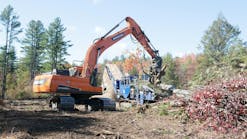When people think of building demolition, they almost invariably conjure up visions of spectacular implosions with large buildings collapsing in seconds. And indeed that is a part of the $2.5 billion business that is building demolition. However, it is a small part, accounting for less than one percent of demolition work. The National Association of Demolition Contractors (NADC) asserts that “more than 99% of demolition work is handled with specialized heavy demolition equipment or skilled manual techniques…. Today’s standard equipment includes the hydraulic excavator with attachments such as grapples, shears, hammers, and concrete crushers.”To that list should be added cranes, loaders, and even balers. (Recently, David Mardigan, president of MCM Management Corporation of Detroit, MI, reportedly announced that his firm purchased an Al-Jon 400 baler. “It has expanded our horizons as a demolition company (because) it is more cost-effective to ship loads (of scrap metal) to market with bales as opposed to boxing loose metal.”)
It should not be surprising that demolition contractors use standard construction-industry tools; after all, they routinely lift down the trusses and other roof support members that some construction contractor once lifted up into place. Also, they must excavate to remove foundations and basements, and they must grade the site at the completion of the demolition job.Similarly, their use of balers, magnets, wood chippers, and other equipment typically used in the recycling industry makes perfect sense too. After all, recycling is a major part of a demolition contractor’s business. According to the NADC, recycling often represents 20-50% of demolition project revenues. With current technology, contractors are able to separate demolition debris and thereby maximize the recovery of resalable materials and consequently reduce waste disposal costs. Thus, demolition contractors have the two best possible incentives to maximize recovery: increase revenues and decrease disposal costs.Not just a demolished building’s wood and metal are recycled either, the NADC points out. “Demolition contractors have become masters of efficient materials recovery. High-value materials suitable for refurbishing or reuse are removed and sold. The salvage industry has grown hand in hand with the demolition industry and is a reliable outlet for architectural features, woodwork, lighting, plumbing fixtures, et cetera. Rare items have established national markets, and there are strong regional markets for fixtures, used brick, decorative items, timbers, and other recoverable material.” And on a more mundane level, concrete and woodwaste also have recycling value. Since there is such a large quantity of these materials at typical demolition sites, concrete crushing and wood chipping can generate significant revenues and preclude landfill costs that would otherwise be incurred. As a result of all these factors, demolition professionals routinely achieve very high levels of recovery.However, their work is by no means routine. A successful demolition project requires a working knowledge of both construction and the law. Decisions involving mechanical and electrical systems engineering as well as environmental regulations must be constantly addressed. Many job problems require innovative solutions based on experience and creativity. And part and parcel of these decisions is the need to control danger in an inherently dangerous environment. Amazingly, most professional demolition contractors have outstanding safety records. For example, Brandenburg Industrial Service Company in Chicago, IL, has a current workers’ compensation experience modification of just 0.51, and its OSHA recordable-incident rate is less than one-third of the national construction-industry average.To illustrate how all this is accomplished, we investigated five separate and diverse demolition projects to see how demolition contractors dealt with site conditions and nonstandard problems. These projects were: The Sears Catalogue Warehouse in Chicago; the Northwest Motor Inn in Crystal Lake, IL; the Metropolitan Airport parking ramp in Minneapolis—St. Paul, MN; the River Center Arena in St. Paul; and the Fort Vancouver plywood mill in Vancouver, WA.Sears Catalogue WarehouseThe Sears Catalogue WarehouseThe tower was saved.The Sears Catalogue Warehouse on Chicago’s West Side is thought to be the largest timber-framed building ever built. Constructed in 1906, this former Sears & Roebuck national headquarters was a nine-story, 3 million—ft.2 timber and brick structure with a distinctive clock tower soaring five additional stories. The building consisted of approximately 23 million bricks and more than 12 million board-ft. of lumber, including 7.5 million board-ft. of heart-pine beams and decking.“Both the bricks and the heart pine were unusually valuable,” states Bill Moore, Brandenburg’s vice president of marketing. “The bricks were Chicago common bricks, much in demand for their yellow-brown color and their smooth texture. What’s more, this smooth texture enabled them to be easily cleaned; one tap with a hammer and the mortar pops right off. With this low-cost cleaning available, recycling of these popular bricks pays off even more than recycling of today’s rough-textured bricks.“The 12-inch by 12-inch by 20-foot timbers were all antique heart pine, a handsome wood that is almost extinct now. Probably 200 to 300 years old when it was cut for this building in 1905, it was too valuable to be reused for structural timber. With its 15 to 20 growth rings per inch, it is commercially marketable at up to $10 per square foot for use as flooring. We had bids for it from antique dealers all over the world before we ever started the demolition.”With the unusually high recycling value of the bricks and the pine, Brandenburg went about the demolition carefully. Employing a fleet consisting of two large, 165-ton American cranes; a half-dozen Koehring excavators equipped with grapples and shears; and both tracked and rubber-tired Cat loaders (973s and 980s), Brandenburg dismantled rather than demolished these materials. The cranes’ clam buckets bit into the 36-in.-thick brick walls and brought each bucketful of bricks down to the surface, where they were cleaned and prepared for shipping by a local crew of a minority business enterprise (MBE) company. Similarly, the pine timbers were carefully lifted down to the surface, and a crew of a newly founded MBE company prepared them for shipment. Most of this planking went to The Joinery Company of Tarboro, NC, where it was sold for use in various projects, such as the restoration of a 16th century tavern in historical Williamsburg, VA.“There were other unusual wrinkles on this project,” Moore recalls. “For example, we had to individually remove 37,000 fluorescent-light ballasts and dispose of them separately since they contained PCB. And we discovered that the foundations were made primarily of brick with a little concrete binding, so we dug out and salvaged these brick, too, before filling and grading the site.”The cleared site made room for the Homan Square Project, an affordable-housing development of 600 new apartments, townhouses, and single-family homes. Setting off the project as a landmark was the 14-story clock tower. Brandenburg had literally dismantled the building around the 50-ft. square clock tower. Crews bricked up the fire doors that had connected the tower to the warehouse and added a new skin around it.“This project involved every aspect of our business,” Moore says. “Large-scale engineering, efficient yet safe operations, environmental issues, political considerations, national and international marketing, recycling, complete salvage, historic landmarks, minority business enterprises.” But today these are considerations that every demolition and dismantling contractor needs to be prepared to deal with.Northwest Motor InnWrecking in progressThe Northwest Motor Inn was a more modest project, but it illustrates how professional demolition contractors develop and adapt equipment and techniques to meet the unique conditions and problems of individual sites. The low-budget project entailed dismantling a 30,000-ft.2, single-story, L-shape hotel built on a concrete slab with face brick. One of the principal requirements was to salvage intact 900 roofing-system wood rafters, each made up of planks that were 2 ft. thick, 10 ft. wide, and 20 ft. long on 1-ft. centers, for reuse by the new owner of the site.The contractor, CornerStone Material Recovery of Richmond, IL, performs demolition and demolition-debris removal and hauling for builders and developers. To perform these varied tasks, the company has adapted standard equipment, adding cranes to its 30-yd.3, open-top hauling trucks. According to CornerStone’s Steve Clements, these hybrid trucks are ideal for cost-effective demolition and source separating of recoverable materials on small jobs and for hauling the debris from project sites.“For the Northwest Motor Inn project, we used these vehicles for the dismantling of the rafters,” he says. “With the crane’s bucket, we literally pinched off several of those 12-in.-on-center rafters at a time and brought them down into the truck, and then stored them for reuse. It kept our labor costs low and enabled us to salvage every one of those rafters.”CornerStone was named Illinois Recycler of the Year in 1994, and it lived up to that reputation on the Northwest Motor Inn project. According to Clements, all of the inn’s metal I-beams were either sold on-site or recovered for later use. Even the signposts and sign panels from the old hotel were sold, and the old-hotel windows were taken to the contractor’s warehouse for reuse. Moreover, air conditioners as well as soffit and face brick from around the windows were recovered, and all the swimming pool water-filter tanks and embedded piping were sold for scrap value.“We recycled 90% of the demolished building,” Clements says. “We knocked down and broke up the concrete block partitions and broke up the concrete slab, footings, and sidewalks at the site. We then took all this concrete debris to a local concrete crushing company, and they crushed it and also salvaged the rebar. We have a reputation of being able to recover materials no one else here can. This keeps escalating landfill fees to a minimum, and that means more stable disposal costs.”Metropolitan Airport Parking RampThis excavator with universal processor is shown breaking foundation walls.Carl Bolander & Sons was able to achieve an even higher recycling percentage at its Metropolitan Airports Commission parking-ramp project in Minneapolis—St. Paul. The project required the removal of a one-level parking ramp to make room for a multilevel parking structure at the expanding airport. According to Bolander Project Manager Larry Langer, the structure was a 320,000-ft.2 precast concrete building with double “T” beams, columns, and spandrels.“Using an American 999 crane, we dismantled the parking ramp using the same process with which it was constructed,” Langer says. “We disassembled each of the ramp’s double-T sections, each of which was 60 feet by 10 feet and weighed approximately 29 tons. We then transported the sections to a storage site for reassembly. We had originally thought that we would truck them directly to the new site 5 miles away, where they were to be erected immediately by the developer of a new warehouse/office building there. Unfortunately, the new owner’s permit was delayed so we couldn’t achieve the seamless project we’d hoped for. However, they’ll be moved from the storage site and reerected this summer instead.“Using Cat 966 loaders with buckets, we also removed and recycled 200,000 square feet of bituminous material that had been below the ramp. We took this material, as well as concrete foundations and any damaged concrete pieces, to our crushing site. We’ll use it for road base on our construction projects. Companies throughout the Twin Cities metropolitan area bring their concrete demolition wastes to our crushing facility for processing into Class 5 or Class 6 aggregate base for road building. We process as much as 200,000 tons of material each year. Very little if any concrete gets landfilled up here.”River Center ArenaVeit & Company might well have been one of those companies using Bolander’s crushing service, but the Rogers, MN, company does so much demolition work that it, too, has its own concrete crushing facility, as well as four construction and demolition (C&D) landfills. Recently, Veit needed much of its total capability when it performed the demolition and excavation work for the arena for the new NFL team, the Minnesota Wild. The work included the demolition of the St. Paul River Center Arena, more than 40,000 yd.3 of overburden excavation, 110 yd.3 of rock excavation, and the structural excavation and backfill for the new Wild Arena.“The demolition project was tricky,” recalls Don Rachel of Veit. “The arena was a circular building 440 feet in diameter. Forty-eight 220-foot trusses, each weighing 20 tons, radiated out to the perimeter from the center ring apparatus. The height of each truss was 3 feet at the perimeter, increasing to 40 feet at the center. What’s more, the steel all had to be lowered to the ground. We had to dismantle the roof structure without any trusses or center ring apparatus free-falling.“We knew that as soon as we removed one truss the whole roof system would be out of balance and might well collapse. To prevent this, we designed and constructed an eight-leg, 63-foot-high shoring-tower system designed to carry a load of about 3.5 million pounds. The shoring tower’s base plates were screwed into the arena floor to preclude any uplift potential and carry the weight of the roof truss system throughout the demolition. Then, one by one, we cut each 220-foot truss free and, using a 318 Link-Belt 80-ton crane, lowered it to the arena floor. There, we cut the trusses into manageable pieces, using a Cat 375 excavator with an MSD 50R LaBounty shear attachment, and trucked them away for scrap recovery. In all, we recycled 2,000 tons of steel.”Once the trusses were removed, Veit lowered the 48 40-ton, 100-ft.-high concrete columns to the ground and pulverized them using a Caterpillar excavator with a concrete-pulverizer attachment. This concrete, plus the concrete seating, amounted to 36,000 tons of concrete that Veit processed at its crushing facility and will use as road base on construction projects. In addition, the 40,000 yd.3 of soil and 110,000 of rock that were excavated were also recycled. (The rock had to be jackhammered out and then crushed by Cat 350s with MPK hammer attachments. The crushed rock was then used for backfill and road base.)“This job certainly didn’t tax our C&D landfill capacity,” Rachel observes. “From this entire demolition and excavation project, only 1,100 tons of C&D were brought to our landfill.”Fort Vancouver Plywood MillNorthwest Demolition and Dismantling of Wilsonville, OR, took on the dismantling and recovery of materials from the 300,000-ft.2 Fort Vancouver plywood mill in downtown Vancouver, WA. In a sense, working in that busy urban location was an advantage, contends Northwest’s Project Manager Richard Wayper, because the dismantled materials could be trucked directly to local salvage and recycling sites without a need to cut them up for efficient long-haul transportation.“There was a huge amount of dimensional lumber–300,000 board feet, in fact–with good commercial value,” Wayper recalls. Therefore, we dismantled the trusses very carefully, one bay at a time, using Komatsu 400 excavators equipped with grapple and shear attachments. These were backed up by Komatsu 220 wheeled excavators to sort and position the dismantled materials in a staging area. There, our crews manually denailed the lumber, cut it to commercial size, and banded it. Then we sold it to several different local lumberyards.“We also pulled up all the foundations and the basement slab and crushed the concrete on-site using our Eagle Horizontal Impact Crusher. Since that machine can crush 1,000 tons of concrete a day, we were easily able to crush the project’s 30,000 tons of concrete into 2-inch-minus aggregate and leave it in piles on-site for use as a structural base when the site was redeveloped. This savings in transportation to and from a remote crushing facility saved the owners a considerable amount of money. All in all, we were able to recycle 98.43% of the total materials [by weight] that we demolished and dismantled. Only 588 tons of the 37,477 total tons had to be landfilled.”With this project under its belt, Northwest took on the demolition and dismantling of another plywood mill, a Potlatch mill in a remote area of Washington at a 4,000-ft. elevation. This time, however, the conditions were quite different. Not only were there no nearby markets for recyclables, but the scope of the job was greater. This time, Northwest’s contract called for it to also sell, recycle, or otherwise distribute a substantial amount of manufacturing equipment before the actual demolition could begin. The company did indeed sell much of the equipment to buyers throughout the nation. It removed the balance of the equipment from the building, cut it up into 4-ft. pieces for ease of long-haul transportation, loaded the pieces (using magnets) into railroad cars, and shipped them to salvage companies located in urban areas.“What remained was a 300,000-square-foot wooden building,” Wayper says, “but this time the building wasn’t made of readily salable dimensional lumber, it was constructed of manmade gluelam timber. And the commercial value of these did not justify the extensive labor that would be needed to recycle them for use as construction wood. Instead, the company decided to grind this wood on-site into hog fuel and ship it via rail or truck to companies that need fuel for their boilers.”As far as the concrete slab is concerned, Northwest is leaving it intact since the site will be reused as a log yard. Thus, neither of the two plywood-mill demolition projects will generate significant waste that must be landfilled, despite their wide differences of scope, transportation, and site reuse.Differences such as these are not too unusual. There are rarely any two demolition projects that have the same conditions and hence the same demolition solutions. According to the NADC, the professional demolition contractor assesses each project with a comprehensive series of site evaluations to determine the unique conditions of that site. “Typical prebid steps include a structural engineering evaluation, which identifies optional methods for [and hazards associated with] taking the structure and its components apart efficiently and safely; a utility survey that identifies connections requiring termination and specifies services needed during the project; a hazardous-materials survey, which identifies materials necessitating special handling and worker training; a safety analysis that incorporates both the structural and hazard information into a preliminary safety plan for the job, specifying additional equipment, training, and materials handling that will be necessary; and a top-to-bottom salvage evaluation that provides estimates of the marketable value of recoverable materials [for reuse or for recycling]–a step integral to minimizing the net costs for all projects.”Armed with this information, the contractor is in a position to do the most cost-effective demolition possible. As a result, the industry has been able to safely dismantle and demolish many different types of structures, achieve high recycling and reuse results that both generate revenues and avoid landfill costs, and do all this at a net cost that is generally less than 2% of the replacement cost of the structure.








